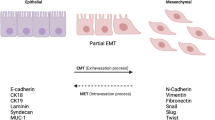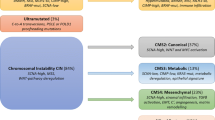Abstract
Purpose
In normal colonic epithelium, the receptor tyrosine kinase, EphB2 interacts with ephrinB1 ligand to maintain the integrity and architecture of the colonic crypt. Loss of EphB2 is seen in most colorectal cancers and correlates with poor prognosis. In this study, we investigated the effects of two levels of EphB2 expression on cell migration and invasion in a colon cancer cell line and on the growth of tumour xenografts.
Methods
An EphB2-negative colon cancer cell line (LIM2405) was transfected with a full-length EphB2 cDNA in a vector designed to respond to the drug tetracycline. The effect of two levels of EphB2 expression on the ability of cells to migrate through a porous barrier in response to a chemo-attractant and to invade through artificial basement membranes was tested in vitro. Finally, the effects of two expression levels of EphB2 on tumour growth using an in vivo model of colonic tumour xenograft in a mouse model were assessed.
Results
Expression of moderate levels of EphB2 significantly reduced the migration of tumour cells compared to control (p < 0.05, Kruskal–Wallis test). Expression of high levels of EphB2 further reduced migration of tumour cells (p < 0.05, Kruskal–Wallis test). Similarly, expression of EphB2 markedly reduces the invasive ability of tumour cells. The in vivo model of tumour growth showed that tumours with the highest level of EphB2 expression had a reduced risk of reaching a 10-mm size (defined event) compared with the control group (Cox regression, hazard ratio (HR) = 0.052, 95% CI 0.005–0.550; p = 0.014). Tumours derived from EphB2 expressing cells had a significantly reduced number of mitotic figures (p < 0.05) and an increased number of apoptotic cells (p < 0.05) compared to tumours from control cells.
Conclusion
Even a moderate level of EphB2 expression has effects on tumour cells which results in reduced migration and invasiveness and slows the growth of colonic tumour implants in an in vivo model.








Similar content being viewed by others
References
AIHW (Australian Institute of Health and Welfare) and AACR (Australasian Association of Cancer Registries) (2008) Cancer in Australia: an overview. AIHW, Canberra
Midgley R, Kerr D (1999) Colorectal cancer. Lancet 353:391–399
Wong MH, Stappenbeck TS, Gordon JI (1999) Living and commuting in intestinal crypts. Gastroenterology 116:208–210
Halloran MC, Wolman MA (2006) Repulsion or adhesion: receptors make the call. Curr Opin Cell Biol 18:533–540
Lackmann M, Boyd AW (2008) Eph, a protein family coming of age: more confusion, insight, or complexity? Sci Signal 1:1–16
van de Wetering M, Sancho E, Verweij C, de Lau W, Oving I, Hurlstone A et al (2002) The beta-catenin/TCF-4 complex imposes a crypt progenitor phenotype on colorectal cancer cells. Cell 111:241–250
Batlle E, Henderson JT, Beghtel H, van den Born MM, Sancho E, Huls G et al (2002) Beta-catenin and TCF mediate cell positioning in the intestinal epithelium by controlling the expression of EphB/ephrinB. Cell 111:251–263
Clevers H, Batlle E (2006) EphB/EphrinB receptors and Wnt signalling in colorectal cancer. Cancer Res 66:2–5
Clarke AR (2006) Wnt signalling in the mouse intestine. Oncogene 25:7512–7521
Polakis P (2007) The many ways of Wnt in cancer. Curr Opin Genet Dev 17:45–51
Maskens AP (1979) Histogenesis of adenomatous polyps in the human large intestine. Gastroenterology 77:1245–1251
Batlle E, Bacani J, Begthel H, Jonkeer S, Gregorieff A, van de Born M et al (2005) EphB receptor activity suppresses colorectal cancer progression. Nature 435:1126–1130
Jubb AM, Zhong F, Bheddah S, Grabsch HI, Frantz GD, Mueller W et al (2005) EphB2 is a prognostic factor in colorectal cancer. Clin Cancer Res 11:5181–5187
Guo DL, Zhang J, Yuen ST, Tsui WY, Chan ASY, Ho C, Ji J, Leung SY, Chen X (2006) Reduced expression of EphB2 that parallels invasion and metastasis in colorectal tumours. Carcinogenesis 27:454–464
Whitehead RH, Zhang HH, Hayward IP (1992) Retention of tissue-specific phenotype in a panel of colon carcinoma cell lines: relationship to clinical correlates. Immunol Cell Biol 70:227–236
Boyden S (1962) The chemotactic effect of mixtures of antibody and antigen on polymorphonuclear leucocytes. J Exp Med 115:453–466
Rentrop M, Knapp B, Winter H, Schweizer J (1986) Aminoalkylsilane-treated glass slides as support for in situ hybridization of keratin cDNAs to frozen tissue sections under varying fixation and pretreatment conditions. Histochem J 18:271–276
Chritchlow DE, Fligner MA (1991) On distribution-free multiple comparisons in the one-way analysis of variance. Commun Stat Theory Methods 20:127–139
Robertson JH, Sarkar S, Yang SY, Seifalian AM, Winslet MC (2008) In vivo models for early development of colorectal liver metastasis. Int J Exp Pathol 89:1–12
Holmberg J, Genander M, Halford MM, Anneren C, Sondell M, Chumley MJ, Silvany RE, Henkemeyer M, Frisen J (2006) EphB receptors coordinate migration and proliferation in the intestinal stem cell niche. Cell 125:1151–1163
Genander M, Halford MM, Xu N-J, Eriksson M, Yu Z, Qiu Z et al (2009) Dissociation of EphB2 signalling pathways mediating progenitor cell proliferation and tumor suppression. Cell 139:679–692
Cortina C, Palomo-Ponce S, Iglesias M, Fernandez-Masip JL, Vivancos A, Whissell G et al (2007) EphB-ephrin-B interactions suppress colorectal cancer progression by compartmentalizing tumor cells. Nat Genet 39:1376–1383
Kumar SR, Scehnet JS, Ley EJ, Singh J, Krasnoperov V, Liu R et al (2009) Preferential induction of EphB4 over EphB2 and its implication in colorectal cancer progression. Cancer Res 69:3736–3745
Herath NI, Doecke J, Spanevello MD, Leggett BA, Boyd AW (2009) Epigenetic silencing of EphA1 expression in colorectal cancer is correlated with poor survival. Br J Cancer 100:1095–1102
Oshima T, Akaike M, Yoshihara K, Shiozawa M, Yamamoto N, Sato T et al (2008) Overexpression of EphA4 gene and reduced expression of EphB2 gene correlates with liver metastasis in colorectal cancer. Int J Oncol 33:573–577
Acknowledgements
This work was supported in part by grants from:
The Ken & Alse Chilton Charitable Trust
The Thomas R & Rosalinda B Ditchfield Medical Research Endowment Fund
The Cancer & Bowel Trust
Author information
Authors and Affiliations
Corresponding author
Rights and permissions
About this article
Cite this article
Senior, P.V., Zhang, B.X. & Chan, S.T.F. Loss of cell-surface receptor EphB2 is important for the growth, migration, and invasiveness of a colon cancer cell line. Int J Colorectal Dis 25, 687–694 (2010). https://doi.org/10.1007/s00384-010-0916-7
Accepted:
Published:
Issue Date:
DOI: https://doi.org/10.1007/s00384-010-0916-7




